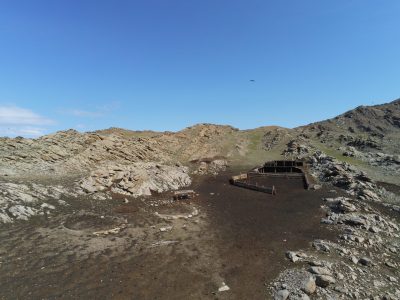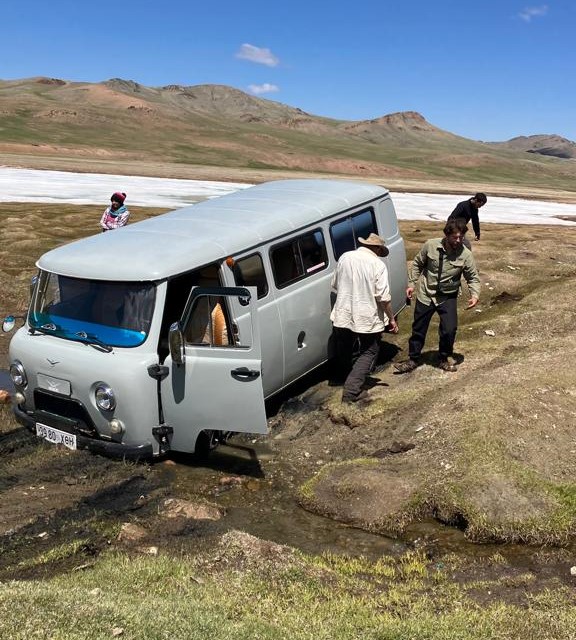
Recent exciting advances in archaeological research on the plains of Mongolia.
During the months of May and June, a multidisciplinary team led by the University of La Laguna, with the participation of members from the GIAP research group (ICAC), conducted new exploration work in the Züünkhangai region.
The main objective of this project was to investigate the nomadic societies of the Bronze Age and their pastoral system in Mongolia.
ZK513: A 4000-Year-Old Winter Camp Still in Use Today
The latest archaeological campaign in Mongolia has provided new insights into ancient nomadic societies and their pastoral way of life.
While the 2023 archaeological campaign had multiple objectives, the team focused their excavation efforts on the known archaeological site called ZK513, a semi-nomadic winter camp that has been continuously occupied for over 4,000 years and is still used today by local herders.

During their stay in the plains, the team also carried out surveys in other areas and discovered new archaeological sites and ritual monuments dating back to the Bronze Age (c. 2600-1700 BC). These findings complement those documented for the first time during a previous exploration campaign in 2022 and help expand our knowledge of this fascinating historical era.
The site ZK513 is unique throughout the Asian steppe because it presents a documented stratigraphic continuity up to the Bronze Age, and it likely extends to the transitional phase with the Neolithic, a chronological period that has been seldom investigated in Mongolia. The archaeological site was first documented in 2018 and immediately caught the attention of researchers due to the high concentration of well-preserved ceramic fragments as well as bone, lithics, and botanical remains, as reported in a first study published in 2022 in the journal Archaeological Research in Asia.

The expansion of the excavation area allowed for numerous findings
Another important task of the campaign was the expansion of the excavation area. By opening two new areas, the team was able to correlate the continuous use of the camp over the centuries.
These findings are crucial for understanding how ancient nomadic societies were organized and how they lived in this pastoral environment.
This year’s campaign expanded the excavation area by opening two new spaces, allowing for spatial correlation of the site’s continuous use. The excavation also recovered abundant archaeozoological and archaeobotanical remains and ceramic fragments. Additionally, the team excavated up to four well-defined combustion structures with abundant charcoal. One of these hearths, of domestic nature, contained a lower level of well-preserved ovicaprid excrement.
The charcoal, seeds, and other plant remains from the sediment of these hearths were recovered using sediment flotation techniques and will be sent to the BioGeoPal laboratory at IMF-CSIC (Barcelona) for further analysis to obtain new data about the type and use of fuel and its provisioning in the local environment.

Specialized laboratory analyses will provide new information about life in past nomadic societies
The excavation was complemented by the collection of intact soil and sediment blocks for micromorphological analysis, and samples of animal excrement, sediment, and ceramic fragments for lipid and isotopic analysis. These analyses will be carried out in the coming months at the AMBI Lab, the Laboratory of Micromorphology and Archaeological Biomarkers at the University of La Laguna.
Through these analyses, we obtain precise markers that allow us to understand the processes of site formation, and learn about the environment, the composition of animals present in the livestock enclosures and their diet, as well as how the herders who occupied the site for millennia also fed themselves.
Lipid and isotopic analyses on sediments will be also applied in samples from a new paleoenvironmental sequence that will provide a more detailed understanding of the dynamics of local vegetation cover over time.
Confirmation of Bronze Age Camps in Züünkhangai
In parallel to the main excavation, the team conducted a series of sondages and small-scale excavations in another domestic site that presented significant surface archaeological scatters and had been documented during the previous year’s campaign. This work confirmed the presence of new pastoral camps continuously occupied since the Bronze Age in Züünkhangai.
As a result, the presence of new continuous Bronze Age herder camps in Züünkhangai has been confirmed.
In addition, we also conducted systematic landscape surveys in the region that were complemented by the intensive use of drones and the automated documentation of archaeological features and structures in 3D using LIDAR sensors on iPads.
This tool saves considerable time in the field while providing reliable and georeferenced digitization of the excavation layers, objects, and even large-scale structures for their rapid inclusion in inventories and heritage catalogs.
In summary, the research conducted during this latest campaign in the Mongolian plains has significantly contributed to our knowledge of nomadic societies and pastoralism in the Bronze Age.
The team’s findings and analyses have opened new avenues to understand the life and activities of these ancient communities in this unique area of history.
With this new information, we learn how these past nomads adapted to the environment, as well as their influence on shaping the region over time; valuable information for anticipating new circumstances in which contemporary societies may need to adapt to climate changes or other environmental circumstances.
We are excited to see what new revelations future explorations will bring!
Nuestro proyecto arqueológico aparece en la revista @NatGeoEsp en su nuevo número de julio dedicado a la Exploración🙌
Con fotografías de @javiercorso, director de @oak_stories, quien nos acompañó en 2022 y pudo documentar la vida tradicional en la estepa.
¡No te lo pierdas! pic.twitter.com/Pz7LYaONFV
— Natalia Égüez (@thethinsection) July 10, 2023
Funding & the team
This year’s campaign is part of the “Archaeology of Nomadic Pastoralism in Western Mongolia” project led by Dr. Natalia Égüez and generously funded by the Palarq Foundation and the Spanish Ministry of Culture and Sports. The team comprises researchers and students from the Catalan Institute of Classical Archaeology (including Francesc C. Conesa and Arnau Carbonell-Puigventós), the University of La Laguna, the Universty of California-Davis and the Milá y Fontanals Institution of the CSIC (Barcelona). This initiative is part of the international project “Western Mongolia Archaeological Project” led by the National Museum of Mongolia and the University of Western Kentucky (USA), in collaboration with the University of Oulu (Finland) and the above-mentioned Spanish institutions.





